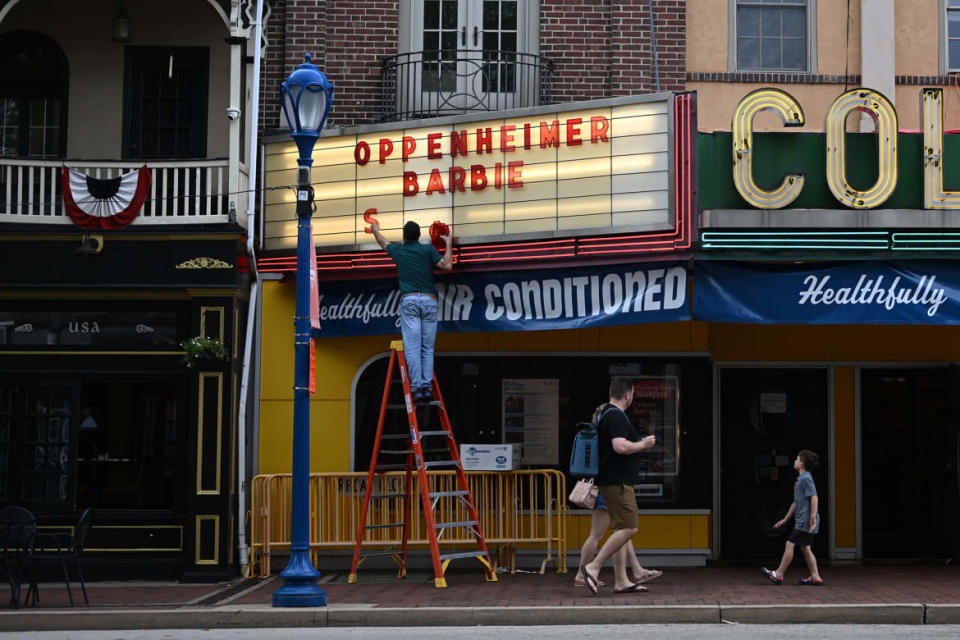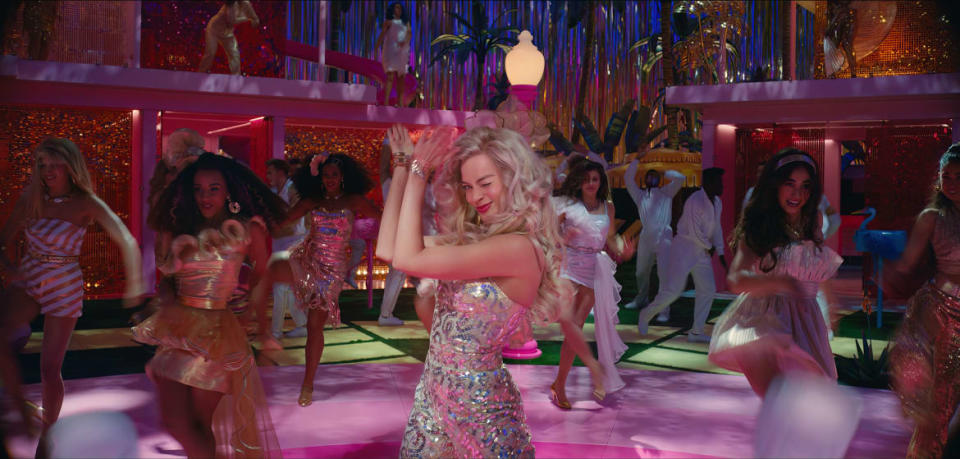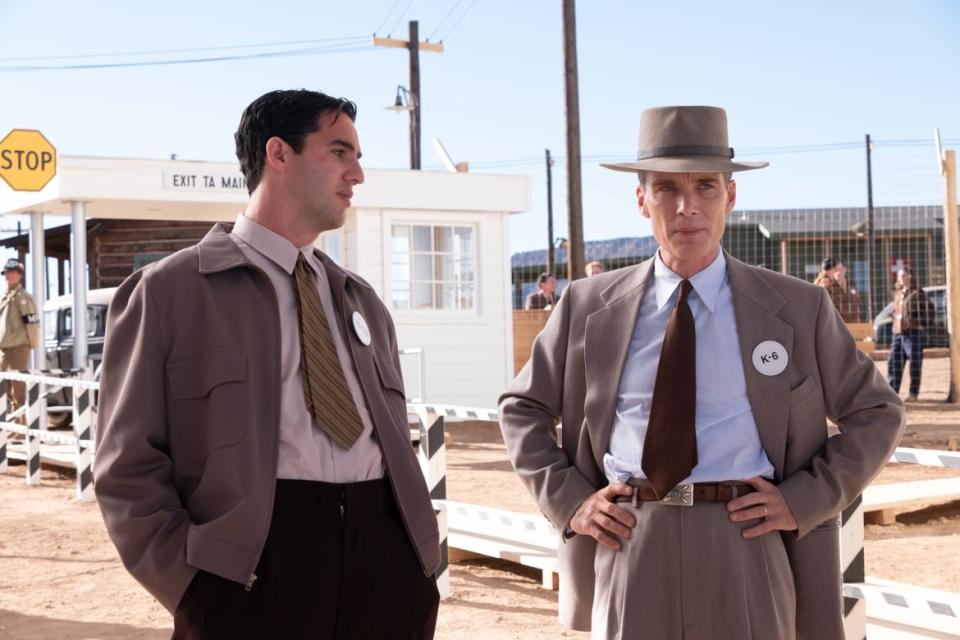Was the ‘Barbie’ and ‘Oppenheimer’ Double Feature Worth It?

- Oops!Something went wrong.Please try again later.
At the nexus of a Venn diagram that includes the WGA and SAG-AFTRA strikes, the advent of AI encroaching on original storytelling in art and entertainment media, and a new post-pandemic chapter ahead is one unlikely filmgoing phenomenon—Barbenheimer. What started as a meme became so much more for dedicated and casual moviegoers. It prompted the existential, pop culture-oriented question of our time: Which movie do I see first on Friday, July 21: Barbie or Oppenheimer? Sure, it’s leaning aggressively into hyperbole, but the stakes could never be higher.
The uniting forces of Greta Gerwig’s Barbie and Christopher Nolan’s Oppenheimer are bringing people together, packed into movie theaters for the event of the blockbuster season. This isn’t just a lackadaisical question of whether or not to catch a flick on a steamy summer Saturday afternoon. Audiences put careful thought and consideration into the trajectory of their day at the movies, from which outfits to wear to whether or not Margaritaville was the best restaurant for a post-movie debrief and, naturally, the order of the films they saw that day. Before the double feature, there was camp Oppenbie — seeing Oppenheimer before Barbie — or team Barbenheimer — watching Barbie back-to-back with Oppenheimer.
Over the course of their shared opening weekend, Barbie and Oppenheimer outperformed box office expectations. Gerwig’s nostalgic feminist feature earned $155 million domestically, the biggest opening weekend for a film directed by a woman, while Nolan’s historical epic garnered $80 million at the American box office.
Behind the numbers and the news, however, audience members who spent a day at the cinema watching both films back-to-back say they enjoyed and endured an experience mere numbers can’t quantify. In a fascinating quasi-psychological study, we spoke to nearly 20 moviegoers, both dedicated cinephiles and fans who wanted to be part of this major moment in popular culture, about which double bill they were going to see and why. Later, we circled back to see how they felt following their double features, as they divulged their Barbenheimer and Oppenbie experiences to us.

Camp Oppenbie
For some, seeing Oppenheimer before Barbie felt equivalent to taking the burning shot before the smooth salve of a chaser. “I’m a staunch supporter of the Oppenheimer to Barbie order,” New York City resident Ben Barzilai said. “I want my dessert after dinner.”
Barzilai wasn’t the only one who felt this way.
“I want to go in with the downer, and end with the upper. Which felt like the most logical approach,” freelance film and TV writer Brianna Zigler said of choosing to start with Oppenheimer. Daisy Maldonado, a shopping editor from New York City, referred to Barbie as seeming like a “palate cleanser” post-Oppenheimer. Those in camp Oppenbie wanted to devour Nolan’s Oppenheimer before savoring Gerwig’s Barbie. The potential impact of Oppenheimer was front-of-mind, they said. So ending the double feature with Barbie felt like the best way to readjust.
“Oppenheimer is such a heavy movie, and I definitely [didn’t] want to end my Friday night on such a heavy note,” Radhika Rahlan, who works in buying for Bloomingdale’s in New York, said.
Knowing the heaviness of Oppenheimer’s subject matter—the film is a biopic of the man who built the atomic bomb—audiences who chose Nolan’s film as the first screening in their double bill wanted to sit with their emotions before entering Barbieland. “I think you want to start with the overwhelming, bleak, and grounded film, and then afterwards, you steel yourself with a strong beverage and let yourself naturally build up optimism before the flurry of lights and colors and sounds of Barbie,” Rory Doherty, a writer from Edinburgh, Scotland, said.

It’s the common tie binding Oppenbie audiences together—approach the day knowing it could be a tough start, but end it feeling more buoyant than bogged down. It’s not only Oppenheimer’s bleak narrative audiences have to account for, it’s also the extra hour run-time. (Oppenheimer clocks in at three hours, while Barbie is a swift hour and 54 minutes.)
Initially, Jamie Rogers, a broadcast director from Eau Claire, Wisconsin, “wasn’t sure which order would be the correct order to see them” before she opted to see Oppenheimer before Barbie. “I think that even if it’s heavy as I head into Barbie, that Barbie will quickly sweep those feelings away,” she said before her Saturday double bill.
There’s only so much these audiences could prepare for, though. While knowing the general topic Oppenheimer covers and a vague idea of what Barbie would have in store, there was still no telling what to expect from the actual experience. “I haven’t prepared myself” for seeing Oppenheimer before Barbie, New York resident Jess Melo said, though she still felt it would “be a good way to end with Barbie, because [the double feature will] end on a high.”
Even with the pastel poppiness of Barbie, some Oppenbie audiences weren’t fully convinced they’d made the right choice. “Originally the plan was to see the longer, heavier, possibly more emotionally draining film before, allow myself to have a break, and then celebrate with something lighter, like Barbie,” Natalie Shepich, who works in film sales in New York, said. “But I have a fear now that Barbie could be more existentially devastating depending what tone [Gerwig] takes with it. In which case, this could’ve backfired on me.”
Finding the right coping mechanism to handle what was potentially coming with Oppenheimer was a major part of audiences’ plans for the day. Ellen Krolow of New York intended to go to Margaritaville in Times Square with friends after Oppenheimer for a complete reset. “You can kind of sit with those feelings, have a little break in between, and then see something that’s, in some ways, lighter…something you can go to bed easier after,” she said.
But others took a different approach entirely. Seeing the films in one day wasn’t an option for Erin Jackson of Atlanta. Instead, she and her crew chose to see Oppenheimer on a Friday night and Barbie the following Saturday morning. “I think it’ll be interesting to give each film their own time to shine,” she said before her first screening, “so it’s not like, ‘Oh I just watched this really heavy movie about the atomic bomb and now I’m going to go watch Ryan Gosling as Ken.’”
Team Barbenheimer
Don your rollerblades, climb a rocket ship, and hop into Barbie’s cotton candy pink sports car — we’re spending some time with team Barbenheimer. In contrast to those in camp Oppenbie, those who went with the order dictated by Barbenheimer wanted to start on a lighter note before steeling themselves up for what they anticipated from Oppenheimer.
“My approach was that I’d always rather start with something that’s a little bit more poppier, leaving me feeling a little bit better, then kind of really let Nolan drop the hammer,” freelance film writer Marshall Shaffer said. “I think it’s the right move.”
Katie Kasperson, who saw the films in Cambridge, England, felt the same way. “I definitely think sleeping on Oppenheimer and having that clean slate is better than Barbie washing it away,” she said. “In other words, I think watching Oppenheimer after Barbie is the better way to go, because it won’t dilute the viewing experience of either film, whereas I feel if I watched Barbie after Oppenheimer it would take away from that intensity.”
Kasperson noted, however, that her choice of order was “under the pretense that Barbie isn’t as serious or intense as Oppenheimer, which might not be the case.”
Making the choice of which movie to see first before knowing the impact of either film weighed on some audience members, who saw the advantages of either order. “On the one hand, it makes sense to want to watch the heavy one last, so you can think about it for the rest of the night without a jarring switch to your mental state,” freelance film writer Daniel Joyaux said. “On the other hand, I think it also makes sense to explicitly not want the heavy one to be your final vibe of the day, and instead let Barbie be a sort of palate cleanser.”

But those on team Barbenheimer felt like they understood the assignment, and they seemed comfortable, confident, and prepared for what was to come, heading into their double features. “I think people are seeing Oppenheimer before Barbie because Barbie might help them recover” from watching Nolan’s film, New York City-resident and editor Summer Cartwright said.
“I also feel like [Oppenheimer] might be a little tough to recover from,” said Cartwright, adding it could make seeing Barbie afterward “a little less fun. How much ‘Kenergy’ do we need to forget atomic bombs exist?”
Let’s Get Clinical
From a psychological perspective, there’s a reason audiences are drawn to seeing these two films as a double feature. “The story to me [of Barbie and Oppenheimer] is relatable across generations. It’s one of those things that doesn’t look very niche,” Dr. Jamie Huysman, a trauma-certified psychologist and licensed clinical social worker, said of the Barbenheimer phenomenon.
Watching a film in the movie theater with an audience allows the “neurological system to feel safe,” Dr. Huysman explained. “The beauty of the theater is that it’s a clinically controlled environment.” In the communal experience of seeing a film together, audiences can make connections, become more self-aware, and even escape from the world, if only for a few hours.
But with two seemingly diametrically opposed films booked as a double bill by more than 20,000 ticket holders, according to AMC, their bodies and minds may go through unexpected changes.
Someone seeing Barbie might “leave [the theater] feeling really good.” It could inspire the release of oxytocin, the chemical that gives you that warm, fuzzy feeling, and help audiences feel “empowered,” Dr. Huysman hypothesizes.
Conversely, watching Oppenheimer might leave people feeling like they’re “walking on eggshells,” due to the subject matter. It might even overwhelm an audience enough to force them “down a pit, a dark hole of existentialism.”
As a result, “if I were to think with my body, neurologically, I would actually go with Barbie first,” said Dr. Huysman. “I just can’t imagine that after three hours of dealing with the end of the Earth, existential [dread] that I’d be ready for anything after that.”
All that said, everything depends on each individual’s self-awareness and emotional intelligence. “We’re all snowflakes,” Dr. Huysman said, referring to humans’ idiosyncrasies and abilities to digest the entertainment media we take in. “Your body and your mind are inextricably bound up. Whatever your mind does, the body keeps the score.”
Post-Op(penbie)
Checking in with the Oppenbie camp, the reactions were, surprisingly, a mixed bag. Those who were once staunch supporters of seeing Oppenheimer before Barbie were surprised that the order either solidified their decision, made them realize you could see Barbie before Oppenheimer, or it didn’t work for them at all.
Ben Barzilai noted the sense of “exhaustion” he felt by the end of the day, and how Oppenheimer felt more mentally than emotionally draining. “By the end [of Oppenheimer] you kind of feel like you’ve lived a whole lifetime. Which isn’t necessarily a bad thing until you realize you have two more hours of movie ahead of you,” he said.
“I definitely think I would have enjoyed Barbie more if I had watched it on a different day,” said Barzailai. “I loved it, but I also feel like I want to watch it again so I can experience it fresh-faced and not watch it when I just spent three hours listening to very complicated dialogue about quantum physics, McCarthyism, and weapons of mass destruction.
“My advice to someone else would be to just treat them the way they were meant to be treated, which is as two separate things,” he added. “Watch them on different days. It’s just not worth it.”
All Right, It’s Time for the Barbenheimer Memes to End Now
Barzilai wasn’t the only one who felt the films deserved their own time. Erin Jackson was grateful that she saw the movies on separate days. “I think it would have been emotionally draining to see both on the same day,” she said.
For Jackson, and those who went with the Oppenbie order, the physical sensations from Oppenheimer were hard to shake. “Every single time they did a test [in Oppenheimer], you could feel it through the speakers,” she said. “Your body really did kind of shudder.”
Audiences used words and phrases like “tense,” “anxious,” “overwhelmed” and “on the edge of [their] seat” to describe certain moments in Oppenheimer. Sometimes those feelings lingered. “I must admit, in terms of sensations, my heart rate was definitely up,” Tasha Jagger, a freelance film journalist who hails from Sheffield, England, said after watching the film. “Perhaps there was some anxiety generated because the subject matter and tone of Oppenheimer is so very dark compared to Barbie’s bubblegum-esque palette.”
Rory Doherty said he felt “shredded with anxiety” during certain moments in Oppenheimer, even though he knew the basic historic events covered in the film. For some, starting on such a heavy note impacted their time watching Barbie.
“I don’t know that seeing Barbie second was the right choice even though I was so confident in the order I chose,” Jamie Rogers said. “I’m less convinced I made the right choice, because I think I would have felt the same about Oppenheimer had I seen it second as I did by seeing it first. But I think seeing Barbie first would have left me feeling more fulfilled by the movie.”
Barbie served its purpose for others, however, acting as a salve to compartmentalize the heaviness of Oppenheimer. Tom Condon, a set dresser who saw the films in Beverly Hills, described how Barbie “reset my mood for the day.” And Doherty said Barbie “felt like a good tonic to the emotional tsunami I had felt that morning with Oppenheimer.”
Ellen Krolow shared a similar sentiment. “How could you possibly see Barbie before you see Oppenheimer?” she asked, following her Oppenbie double feature. “I came out of the theater sobbing.” Krolow said Gerwig’s Barbie left her feeling “soft,” and noted how much the themes touched her emotionally. “At the end of the day, which one will I see in the theater again for sure? Oppenheimer. Which one will I watch more in my life? Barbie.”
It wasn’t just the film itself that changed the mood. Audiences for Barbie screenings created an atmosphere that quelled any sense of dread. “You could really feel how happy people were to be in the theater seeing [Barbie]. That was just such a great feeling. You could feel the excitement,” Brianna Zigler said. “It was so electric.”
And by the time she walked out of the theater, Zigler felt the films made for a “great double feature” regardless of their order. “Flip-flop them. Either way, you can’t lose.”
After Barbenheimer
“I think the best order would be Barbie, Oppenheimer, Barbie, Oppenheimer on an infinite loop,” Summer Cartwright said after her Barbenheimer double bill. “You really leave [Barbie] feeling refreshed and energized—very excited to be a woman.” She added that Barbie felt like a “warm-up” for Oppenheimer. “I was so anxious during Oppenheimer,” she said. “I have asthma too and I was like, ‘I should have brought my inhaler.’”
Most Barbenheimer viewers felt comfortable with their choice. Stephen Snow, who saw Barbie and Oppenheimer with less than an hour apart at New York City’s Lincoln Square AMC theater, said he “could not imagine doing the opposite order.”
Katie Kasperson shared the same sentiment. She “really enjoyed” Barbie as the first feature in her double bill, saying, “I do still feel like Barbie-then-Oppenheimer was the right way to go.”
The experiences of the Oppenbie and Barbenheimer audiences presented their own differences: how people left the theater, how they spent their day, and the emotions they had to wrestle with thereafter. But there was one overwhelming quality everyone agreed on for both films: “The crowd was incredible,” Cartwright said.
It’s been years since we’ve had a cultural moment, a reset, that reflected the unadulterated joy of heading to the movie theater. It’s certainly the first one of this magnitude since the pre-pandemic days; a few people mentioned that they hadn’t seen an occasion like this since Avengers: Endgame, which premiered in April 2019. What started as a tongue-in-cheek internet meme became an occasion, the event of the summer. And every person, regardless of which order they saw Barbie and Oppenheimer in, was just happy to be back in the theater with a huge audience.
“That was my main takeaway—I didn’t know I’d get so excited seeing so many people,” said Natalie Shepich. “I didn’t realize how much I missed seeing people packed into theaters.”
Check out more of our BARBENHEIMER coverage:
The ‘Barbie’ Movie’s Best Line Honors the Beauty of Older Women
The ‘Oppenheimer’ Sex Scenes Are Cringey, But Not Because of the Sex
What ‘Barbie’ Critics Are Getting Wrong About Its Big Monologue
Get the Daily Beast's biggest scoops and scandals delivered right to your inbox. Sign up now.
Stay informed and gain unlimited access to the Daily Beast's unmatched reporting. Subscribe now.

